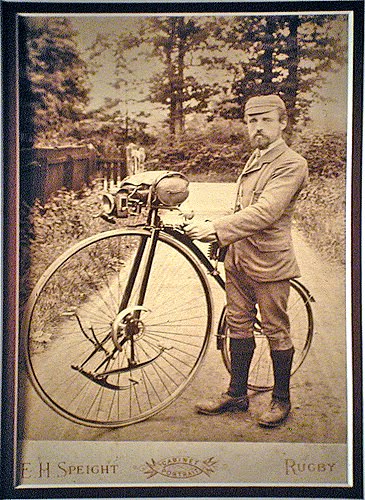Last shedweek I made the saddle mount, the near vertical post that clamps to the backbone. This shedweek, I've made the little doodad that clamps to it and carries the saddle springs. I'm not sure what the correct name is for this part but I'll call it the spring carrier for want of a better term. It's a lovely little thing, very pleasing to look at.
Spring Carrier Doodad.
Calculations on the original facile example and a few others I have handy showed me that I could machine the shape from a 1" bar.
The first step is to mill an identical flat on either side of the bar so that the final thickness is 0.75". This was the first proper use of my new milling machine, the finish is OK but not that great at present, I'll try a new belt to see if I can even out the finish. The finish is not important in this case since so much of it is going to be removed through subsequent operations.
The next step is to drill three holes in one of the flat faces, the two end holes are tapped at 1/4" cycle thread as a temporary means of mounting to a face plate, these end holes are where the springs will be mounted. The middle hole is used to centre the bar on the face plate.
Then bore the central hole to be a nice fit onto the saddle post.
Next machine the side on profile using a profile tool. This type of interrupted cut is very hard on tools, even using small feeds. The finish is unimportant since it will be hand filed later.
Next remount at 90 degrees using an old section of angle iron. Mark and bore the cross hole for the 3/8" bolt to clamp the carrier to the saddle post.
Then machine the profile of the side.
Flip around and machine the back of the carrier in the same way.
Finish with hand files and make the 2 bolts to hold the springs and the larger one to secure the carrier to the post.
In other news, I'm being tossed on the horns of a dilemma. In our house, we try hard not to go mad on Christmas presents. Sure, the kids get a little spoilt and they get things that I would have loved as a child but I'm talking about presents to each other, to my lovely wife. Officially we have a complete spousal gift moratorium. We both agree in advance not to be silly and to treat the festive season as a time to spend together as a family with the necessary reduction in shed based activities. Unfortunately, I happen to know for a fact that my lovely wife has bought me something this year. My daughter told me. What do I do? If I buy her something, I'll have let on that I know that she bought me something and if I don't buy her something I may as well go and live in the shed until next year. I can't win. I think the solution is to buy her a present and wrap it in a generic Christmas/birthday style wrapping paper, then hide it down the back of the sofa rather than under the tree. If I'm right and she has got me a present I can whip it out and still be in favour and if I'm wrong and she hasn't broken the gift embargo, then I can just keep it until her birthday in August. Sorted.
Whatever, happy Christmas to both of my readers.





















